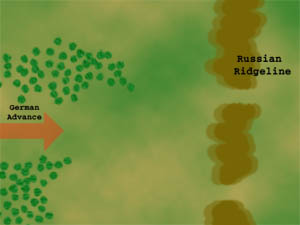HIGH SUMMER HELL (Individual Missions)
A Gear Krieg Scenario in Three Parts by Scott Lynch
I. Encounter in the Dawn: 0630 Hours
Situation and Set-Up
The battlefield is dominated by a huge copse of trees (scatter Rough and Woods terrain) surrounded by gentle grasslands. Each side may set up within 6 MU of their respective map edges.
Both sides receive those units previously allocated from available forces.
No units may begin the scenario dug in, although players may designate which are already moving at top speed.
|
 |
Mission Objectives and Victory Considerations
Both sides are charging to capture the woods and intend to use their cover to hold off the enemy probe. When one combatant decides that the objective is untenable, he may withdraw his surviving forces off his edge of the map. Any units so withdrawn may be placed into the available forces for the battle of the "Dragon's Ridge." This mission will be over when the last unit from one side has been withdrawn or destroyed.
Units withdrawn and placed into the next mission do not have their damage repaired or their ammunition replenished.
The winner in this engagement may add the following to their available forces for either of the next two missions:
If Soviet: 4 x KV-1C Tank (Rookie)
If German: 2 x PzKpfw II Ausf D Tank (Veteran)
II. Dragon's Ridge: 1100 Hours
Situation and Set-Up
The Soviets hold a fortified line situated along a rocky ridge. Consider the ridge Rough terrain, with a slope as described in the GK sourcebook (+1 MP to enter a ridge MU from the surrounding clear terrain). The Germans are attacking from a nearby forest split by several areas of clear terrain. There should be 5-10 MU of clear space between the last of this cover and the ridgeline itself.
The Germans may set up anywhere within 15 MU of their map edge, and the Soviet units may be set up anywhere from the ridgeline back to their own map edge. The Soviet player may designate which units on the ridge are dug in or hull-down as the scenario begins. Soviet units in this scenario are entitled to their customary defensive morale bonus.
|
 |
Mission Objectives and Victory Considerations
The Germans have a difficult assault before them, but they have no other position from which to attack the ridge. They must scale those heights, turn out the defenders, and drive them back. The Soviets, of course, wish to ensure that the Germans come to a screeching halt right in front of them. As before, when one player feels that victory is out of his grasp, he may attempt to withdraw his surviving forces off his map edge and add them to those available for the "Crossing Under Fire."
The winner of this engagement may add the following to their available forces for the final mission:
If Soviet: 3 x Model 39 AT Gun (Rookie)
If German: 2 x 5 x PzKpfw V Aust B "Valkurie" Walker (Veteran)
II. Crossing Under Fire: 1500 Hours
Situation and Set-Up
The dominant feature of the landscape is the Dnieper River, 2 MU wide, crossed only by a single sturdy bridge. The Soviet side of the riverbank should be scattered with Rough and Woods terrain. The German side of the riverbank should be mostly Rough with one or two patches of Woods.
A dirt road bisects the map, leading to and from the bridge.
Soviet units may be set up anywhere on the Soviet side of the river line, and may be dug in at the designation of the Soviet player. German units may be set up anywhere on the German side of the map at least 8 MU back from the river.
Both sides receive those units previously allocated from available forces.
|
 |
Mission Objectives and Victory Considerations
The Germans are approaching a bridge on the Dnieper River, faced with the unhappy prospect of an assault without the aid of boats. Their only chance is to storm across the (miraculously intact thanks to an inept Red Army engineer) bridge under a hail of fire and prepare to take heavy casualties. If they can take the bridge, it might almost be worth it.
The Russians, of course, sternly disapprove of the Germans' intentions and are prepared to argue their point.
The first side reduced to three or fewer operating units will lose this engagement.
Variations and Complications
The Vicissitudes of War
Have you consulted your Random Snafu Generator today?
They Did Have Boats After All
Attacking two prepared defensive lines in one day is a bit rough. If both players consent, German infantry units participating in "Crossing Under Fire" scenario may be equipped with rubber assault boats. To use them, an Infantry unit must reach the river's edge and spend 1 MP to set the boats up. Once the boats are set up, the units may move across the river at 1 MP per turn. On the turn in which they come adjacent to the opposite bank, they may use 1 MP to get off the boats and up onto the bank. During the crossing, infantry may take casualties as per normal, but they may not fire back.
Designer's Notes
Although I didn't realize it at first, I believe this scenario set gives GK players the most flexible and potentially educational command responsibility of any of my lot so far. In the first two scenarios, victory is determined by the side that breaks off and tries to cut its losses the soonest. In doing so, they lose one battle, but preserve some of their forces for the next engagement. Field exercises with General Eisenhower it ain't, but at least it's a bit better than the usual default victory condition of "last man standing."
For some reason, I'm having a major flashback to the "Close Combat" series of computer games... hmmm...
Ghosts of the Steel Age |
Gear Krieg Scenario Bank |
Snark Hunt Main |


